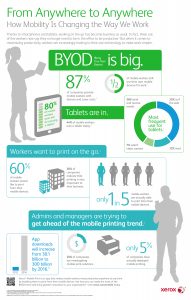
How to enable today’s mobile workers for success
December 9, 2016 | By Ken Van Aelst

Increased mobility practices bring both opportunities and challenges to administrators, managers and IT departments.
According to a Ryerson University survey, 70 per cent of Canadian employees are mobile in some way (physically) and this was expected to increase to 73 per cent in 2016. As enterprises move to an increasingly mobile workforce, they face the challenge of adapting legacy document workflow to a mobile document environment. Employees today are only as mobile as the process allows them to be. Without a mobile strategy that includes document workflow, device use by mobile workers might be limited to making calls and just checking e-mail.
For a successful outcome, two issues must be resolved: how to integrate mobile usage into an existing enterprise workflow, and how to print from a tablet or other device when the task requires it. Workers can be more responsive and productive when they have the documents they need anywhere, anytime. To help facilitate this some print service companies offer managed print services (MPS), a program that manages all aspects of your business’s printing devices, including printers, scanners, faxes and copiers.
The optimization of these devices enables businesses to save money, produce less paper waste and increase efficiency. The reason is that an MPS provider is already thinking in terms of the totality of your document output environment and the processes connected to it. When considered as part of a total MPS offering, mobile print becomes a means of helping employees get work done more efficiently by providing document accessibility without compromising information security.
Integrating mobile workflow with legacy processes sounds complicated, and it is certainly nothing to jump into without preparation. This is where an MPS vendor can help to fill in the gaps. MPS is as much about document processes as it is about document output. Leaders in the MPS space offer assessment tools and other solutions to the challenges faced by businesses as they move to a fully mobile workforce. With these resources, they can look deeper into your document environment and uncover ways to incorporate mobile print into your MPS, and by extension, into your business processes.
OVERCOMING COMPLICATIONS
Processes that use hybrid documents further complicate the situation. In some processes, documents are born digital, then become paper and eventually convert back to digital. For example, a contract may be auto-filled online, printed for a signature, then scanned into the customer database. Sometimes paper documents turn digital and stay that way. Dealing with business workflow requires you to manage the transitions between the two forms. A workflow analysis by your MPS provider can lead to better understanding of the transitions between paper and digital and back.
However, that is just a part of it. You also have to consider document fluidity in mobile work environments. You cannot enable a mobile workflow strategy without first considering the processes in which employees work. An MPS vendor can help to identify and solve a mobile process gap or inefficiency.
OPTIMIZE WORKFLOW
Just as you optimize processes to increase productivity and streamline service, now you can start thinking in terms of how to do the same with mobile workflow. Aim for a mobile strategy that increases productivity by keeping users connected to their enterprise document workflows. What are the points where a mobile worker touches enterprise content? How can you solve business challenges, optimize service and reduce costs by leveraging mobile workflow? Finally, consider the processes in your company that could benefit from giving workers, business partners or even customers the ability to print from any mobile device to any printer.
Ken Van Aelst is the vice president of Eastern Operations for Xerox Canada and is based in Montreal.




